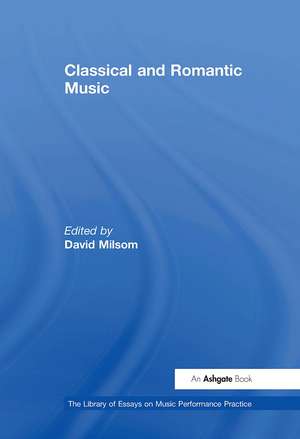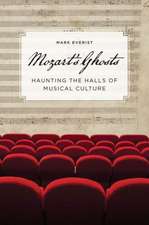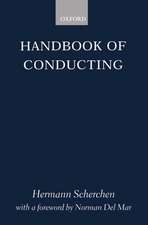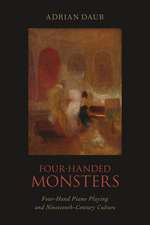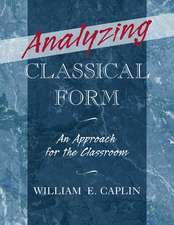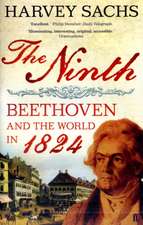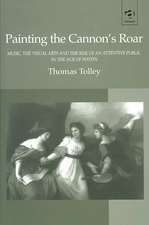Classical and Romantic Music: The Library of Essays on Music Performance Practice
Editat de David Milsomen Limba Engleză Paperback – 14 oct 2024
| Toate formatele și edițiile | Preț | Express |
|---|---|---|
| Paperback (1) | 226.75 lei 6-8 săpt. | |
| Taylor & Francis – 14 oct 2024 | 226.75 lei 6-8 săpt. | |
| Hardback (1) | 1474.28 lei 6-8 săpt. | |
| Taylor & Francis – 20 iul 2011 | 1474.28 lei 6-8 săpt. |
Preț: 226.75 lei
Preț vechi: 264.21 lei
-14% Nou
Puncte Express: 340
Preț estimativ în valută:
43.39€ • 44.83$ • 36.11£
43.39€ • 44.83$ • 36.11£
Carte tipărită la comandă
Livrare economică 25 martie-08 aprilie
Preluare comenzi: 021 569.72.76
Specificații
ISBN-13: 9781032919058
ISBN-10: 1032919051
Pagini: 528
Dimensiuni: 169 x 244 mm
Greutate: 0.98 kg
Ediția:1
Editura: Taylor & Francis
Colecția Routledge
Seria The Library of Essays on Music Performance Practice
Locul publicării:Oxford, United Kingdom
ISBN-10: 1032919051
Pagini: 528
Dimensiuni: 169 x 244 mm
Greutate: 0.98 kg
Ediția:1
Editura: Taylor & Francis
Colecția Routledge
Seria The Library of Essays on Music Performance Practice
Locul publicării:Oxford, United Kingdom
Public țintă
AcademicCuprins
Contents: Introduction; Part I Style and Purpose: Appraising 18th and 19th Century Aesthetics: Performing Classical repertoire: the unbridgeable gulf between contemporary practice and historical reality, Clive Brown; Mozart as early music: a Romantic antidote, Laurence Dreyfus; Listening and responding to the evidence of early 20th-century performance, Daniel Leech-Wilkinson. Part II Studies in Historical Sources: Mathis Lussy's Traite de l'expressione musicale as a window into performance practice, Michael D. Green; Quantz's unegal: implications for the performance of 18th-century music, Claire A. Fontijn; The recordings of Joachim, YsaÃe and Sarasate in light of their reception by 19th-century British critics, Dorottya Fabian. Part III Instruments, Ensembles and Conducting: Towards a Verdian ideal of singing: emancipation from modern orthodoxy, Roger Freitas; Brahms's pianos and the performance of his late piano works, Camilla Cai; The orchestra in Beethoven's Vienna, Clive Brown; Mozart's Viennese orchestras, Dexter Edge; Rejected traditions: ensemble placement in 19th-century Paris, Donna M. Di Grazia; Style and sonority in Wagner string performance, David Milsom; The origins of the ideology of authenticity in interpretation: Mendelssohn, Berlioz and Wagner as conductors, José Antonio Bowen. Part IV Tempo and Rhythm: Historical performance, metronome marks and tempo in Beethoven's symphonies, Clive Brown; The case of compensating rubato, Sarah Martin; Tempo as an expressive element in the late Romantic lied, Edward F. Kravitt; New light on late 18th-century tempo: William Crotch's pendulum markings, Emanuel Rubin. Part V Aspects of Notation: Dots and strokes in late 18th- and 19th-century music, Clive Brown; The expressive pause: punctuation, rests and breathing in England 1770-1850, Robert Toft; Beggar at the door: the rise and fall of portamento in singing, John Potter; Bowing styles, vibrato and portamento in 19th-century violin playing, Clive Brown; Port
Notă biografică
David Milsom, who has written widely on nineteenth-century performing practice, is the author of Theory and Practice in Late Nineteenth-Century Violin Performance 1850-1900 (Ashgate, Aldershot, 2003). He is an active violinist and violist, specialising in late nineteenth-century violin performing practice and an experienced instrumental teacher. He is a lecturer in music at the University of Huddersfield.
Descriere
This volume brings together twenty-two of the most diverse and stimulating journal articles on classical and romantic performing practice, representing a rich vein of enquiry into epochs of music still very much at the forefront of current concert repertoire. In so doing, it provides a wide range of subject-based scholarship and reveals a fascinati
